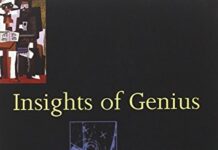
Ebook Info
- Published: 2014
- Number of pages: 352 pages
- Format: PDF
- File Size: 14.26 MB
- Authors: Arthur I. Miller
Description
A dazzling look at the artists working on the frontiers of science. In recent decades, an exciting new art movement has emerged in which artists utilize and illuminate the latest advances in science. Some of their provocative creations―a live rabbit implanted with the fluorescent gene of a jellyfish, a gigantic glass-and-chrome sculpture of the Big Bang (pictured on the cover)―can be seen in traditional art museums and magazines, while others are being made by leading designers at Pixar, Google’s Creative Lab, and the MIT Media Lab. In Colliding Worlds, Arthur I. Miller takes readers on a wild journey to explore this new frontier. Miller, the author of Einstein, Picasso and other celebrated books on science and creativity, traces the movement from its seeds a century ago―when Einstein’s theory of relativity helped shape the thinking of the Cubists―to its flowering today. Through interviews with innovative thinkers and artists across disciplines, Miller shows with verve and clarity how discoveries in biotechnology, cosmology, quantum physics, and beyond are animating the work of designers like Neri Oxman, musicians like David Toop, and the artists-in-residence at CERN’s Large Hadron Collider.From NanoArt to Big Data, Miller reveals the extraordinary possibilities when art and science collide. 70 illustrations, 8 pages of color
User’s Reviews
Editorial Reviews: From Booklist Science historian Miller coins the term artsci to describe the growing realm of creativity that merges art, science, and technology. Beginning his exploration in the early twentieth-century artistic engagements with X-rays and radio waves, Miller goes on to map a wide-ranging contemporary field of practice that encompasses computer-based art, robotics, data visualization, and biotechnology. This well-illustrated and accessible text is refreshingly short on academic theory, instead surveying the vast landscape of artsci through profiles of individual artists, projects, and institutions. Tracing collaborations at the CERN Supercollider, Pixar Studios, and the MIT Media Lab, Miller finds particular inspiration in artworks that go beyond the illustration of scientific principles and actually contribute to real-world scientific advances. Miller’s anecdotes of bioluminescent brains, emotive interfaces, and climate-change mappings trace an exciting new avant-garde of creative research with the potential to realign aesthetics toward an appreciation of information. The author’s comprehensive text not only codifies an important contemporary cultural movement, it also marks the rise of an interdisciplinary “third culture” that fuses the disciplines of art and science. –Lindsay Bosch Review “[An] encyclopedic survey… Dr. Miller’s grasp of the scene is impressive.” ― Jascha Hoffman, New York Times Book Review”[Arthur I. Miller] deftly demonstrates in this survey of what he calls “artsci” [that] both artists and scientists…have probed the porous borders between art and science, creating aesthetic objects that incorporate scientific ideas… Miller eloquently chronicles the story of artsci in brief vignettes of the lives and works of the individuals working at the intersections of these disciplines.” ― Publishers Weekly (starred review)”Arthur I. Miller understands the intersection of art and science better than anyone writing today. In Colliding Worlds, he brilliantly helps us expand our definitions of art and science while encouraging us to appreciate how both involve an intuitive feel for the beauty of the unseen.” ― Walter Isaacson, author of Steve Jobs”Arthur I. Miller explores what happens when the brainwaves, objectivity and logic of science spark off the inspiration, subjectivity and wildness of art, and vice versa. After tracing out the contacts between these spheres of endeavor, Miller goes even further, suggesting that the boundaries between them are breaking down: science is redefining contemporary art to seed a third culture.” ― Roger Highfield, director of external affairs, Science Museum, London”Arthur I. Miller’s Colliding Worlds answers the age-old question of whether art and science can find common ground with a resounding YES! From the foundations of Cubism to bacterial radios, fluorescent rabbits, and musical hyper-instruments, Miller’s easygoing, anecdotal, and wide-ranging narrative shows how artists exploit cutting-edge advances in science and technology to alter dramatically the palette of artistic invention.” ― Mark Pagel, author of Wired for Culture”Arthur I. Miller has the rare intellectual range to address the ways modern scientific discoveries have nourished the creativity of artists―and that’s what he’s done in this fine book.” ― Martin Rees, Astronomer Royal and author of From Here to Infinity”Illuminating… [A] philosophically rich study of creativity and aesthetics.” ― Grace Labatt, Santa Fe New Mexican About the Author Arthur I. Miller is a professor emeritus at University College London. He has published many critically acclaimed books, including Einstein, Picasso; Empire of the Stars; and 137. He lives in London. Read more
Reviews from Amazon users which were colected at the time this book was published on the website:
⭐A comprehensive review of the current state of the intersection of art and science/technology. It offers an overview of some of the names out there, both contemporary and from the past. Also it goes past some of the most important milestones of the history of this branch of artistic endeavors, altogether with the institutions, events and spaces that have played and play a part in it.An overall interesting read, with some of the authors anecdotal insights and positions.
⭐This is a brilliant and important book. Arthur not only surveys this most exciting field, but through his copious original research, presents the people and stories behind the work. The result is much more engaging and informative than the usual academic and technical survey. The thesis, on the merging of science and art, is an important area of our cultural development. As science and technology grow and increasingly influence every corner of human existence, the nature of the mix is an important question. Arthur stakes his claim and takes you an an illuminating journey that will leave you at least sympathetic if not convinced. (full disclosure: I am a subject of the book)
⭐Excellent and comprehensive text on permutations of art-science. One of the best sources on this intersection. Highly recommended.
⭐We were very happy with the book, especially the chapter on our friend Dr. Richard Taylor.
⭐i found the book idiosyncratic and not a significant addition to the literature=i recommend steve wilson’s ‘information science’ instead although it is a few years old
⭐This is a fascinating and hugely knowledgeable and wide-ranging account of the relationship between art and science in the twentieth and twenty-first centuries. From the creative dialogue between Einstein and Picasso, through the mechanical experiments in New York of Rauschenberg and Kluvier to the weird transformations of their own bodies performed by Stelarc and ORLAN, Arthur I. Miller traces what he calls the new avant-garde, in which the boundaries between the disciplines of fine art and science and technology are breaking down. In the process he raises some important questions, about whether we need to find a new kind of aesthetics and whether our concept of beauty is changing, and he highlights some very interesting repercussions of the science/art interface: the role of fractal analysis, for example, in authenticating a Jackson Pollock painting, or the extent to which art can make visible the invisible at the Hadron Collider in CERN. I was not entirely convinced by his argument that the boundaries between art and science only really started blurring in the early twentieth-century; it seems to me that creative thinkers have always been interested and deeply read across subject areas. Think Newton and Blake on optics, or Coleridge and Humphrey Davy. But I guess Miller had to begin the narrative somewhere for the book to be at all manageable. All in all, this is a highly engaging, well-written and passionate analysis of a very important subject, which should be essential reading for artists and scientists alike.
⭐C.P. Snow in The Two Cultures and the Scientific Revolution (1959) never envisioned someone like Arthur Miller would come along. Miller is a physicist, he has an encyclopedic knowledge of contemporary art, and he writes well. When I began hanging out in the New York art scene in the 1960’s, most of the artists were crazier than the proverbial mad scientist. The art community was staunchly anti-science, really anti-everything but sex drugs and rock and roll. Art now is nothing like it used to be, even for artists who still mix colors. Miller’s book reads like an excellent history of the mayhem that made contemporary art the dominant art form, at least for the moment. Historians in the future, however, will study the work as representative of its time. Colliding Worlds conveys Miller’s singular experience of the revolution.
⭐I really enjoyed this book and also learnt a great deal from it. It’s a gripping account of what’s going on in the world of art, where artists work alongside scientists to create works that express our modern scientific age. There are all sorts of extraordinary artists and artworks described here, from some who experiment on their own bodies to some who make sculptures depicting data and others who work in sound. Most informative and very enjoyable and lots of good illustrations
⭐Fascinating and readable account of the confluence of Art and Science. Arthur Miller is a genius.
⭐I found this book very useful for researching art/science collaborations. It gives a good general overview, interesting historical background and excellent information to researching further. After reading the Kindle version I ordered the hard copy. Says it all if I bought it twice.
Keywords
Free Download Colliding Worlds: How Cutting-Edge Science Is Redefining Contemporary Art in PDF format
Colliding Worlds: How Cutting-Edge Science Is Redefining Contemporary Art PDF Free Download
Download Colliding Worlds: How Cutting-Edge Science Is Redefining Contemporary Art 2014 PDF Free
Colliding Worlds: How Cutting-Edge Science Is Redefining Contemporary Art 2014 PDF Free Download
Download Colliding Worlds: How Cutting-Edge Science Is Redefining Contemporary Art PDF
Free Download Ebook Colliding Worlds: How Cutting-Edge Science Is Redefining Contemporary Art



